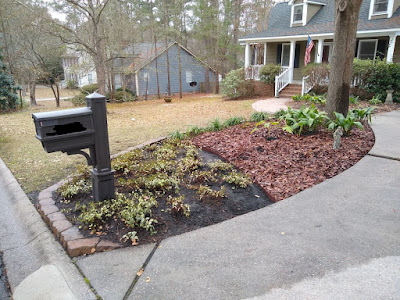 |
| Phase One - After |
We chatted and walked his property. There were some interesting plants, beds and many concerns.
Some foundation plants were harmed by someone who cleaned the roof, but that's for another time.
As usual, I wanted to find that one priority area of the customer's for which to begin. It (the before photo), the bed to re-work, was installed by another party over a year ago.
This is just phase one, so please bear with me.
If this had been a well-established bed prior, I probably wouldn't have recommended a soil test. I'm glad I did. Firstly, when we went to take soil samples, we were digging through roughly three to four inches of compost to get to the top soil - not good.
 |
| Phase One - Before |
I wouldn't have been so concerned specifically with this bed had the test results for nearby soil not been acidic (common in this area) by a great difference.
Most plants do well in acidic soil (pH 5.5 to 7.0). Something had been introduced to this bed to increase the pH - most likely, this large amount of compost.
Compost should be used during planting, worked into to soil (not roto-tilled except for something like a vegetable garden) or lightly layered - incorporated or not so predominant. Compost is not truly decomposed (will, eventually) when we buy it and it goes through large pH swings in the process. Slight changes are usually fine.
I do like the location, border and grade of the bed; however, this is a fairly shaded lot so plant selection and placement is key. To allow more sunlight and a wider selection of plants we raised the canopy of the tree and made some heading cuts on some of the other branches.
I'm not a big fan of dyed (mostly safe chemicals are used) mulches because I don't find these red and black colors in nature and mulches are mostly natural, or should appear so. However; I have seen some attractive beds using dyed mulches. To me, aesthetically, this has to do with the man-made and natural surroundings.
 |
| Phase One - After |
Black, double hammered (shredded, actually) hardwood mulch was in the existing bed. I have nothing against this type of mulch (it has its benefits), particularly in evergreen and/or herbaceous perennial beds with no nearby deciduous trees or shrubs. It is not so easy to clean leaf and needle debris from. Medium pine bark nuggets were chosen for the re-work.
Something was askew with the plant layout - some grouping and lines I couldn't understand:
- Asiatic jasmine grouped, but too scattered/sparse. There were some in the rear of the bed as if they were specimen plants - gorgeous, but they aren't stand-alone specimens. Asiatic jasmine can be a wonderful ground cover bed when planted close enough to one another. There was also a cordyline plant in the midst of them. We grouped them closer together, provided no mulch to allow them to better root as they spread and installed metal edging on one side to keep the other mulch out and allow for easier edging in the future. Eventually, the asiatic jasmine will develop into a single dense bed, hugging and trailing the mailbox.
- The monkey grass (Liriope muscata - non-spreading species) was lined up like little soldiers. This type of liriope does well along borders, so we moved them.
- Where I expected to see some symmetry, I didn't. The cast iron (Aspidistra elatior) plants around the tree, seemed to be haphazardly placed. We rearranged these.
- We also moved some daffodils from around the mailbox to a corner in the rear of the bed.
The remainder of the mulched area is intended to be the plant playground for the customer. There are already a few Coral Bell (Huchera) - all the same species and color, for some reason; one or two ferns and a Fatsia; and now, the Cordyline we transplanted.
The customer wants to add some color and some height in the coming weeks or months. A deep red or burgundy dwarf japanese maple was discussed. There are other options, perhaps some colorful perennials and/or some annuals, depending on the desire to replant each year, in the latter case.
I would like to show foliage and some blooms throughout most of the year. This will mean less maintenance, yet may not provide the more dynamic, yet shorter-lived blooms of some annuals - the customer's call. He seems prepared for dealing with colorful annuals, so the options have broadened. We'll support him, either way.
All the existing plants can be transplanted easily to accommodate new plants and a new layout. Hopefully, the soil conditions will recover and the pH of the soil will approach neutral or slightly acidic over time, better accommodating the existing and new plants.
This coming summer will be the test, but next summer may best show, summarize and highlight the customer's and our efforts.
I will always love dealing with existing plants, shrubs and trees - pruning and the care of, but planning a plant bed and orchestrating its installation is terribly rewarding.
For me, it is still one step at a time and I usually have to await the full benefit of our efforts when installing new plant beds. But, we (us) can plan and try to influence Mother Nature all we want, but She still makes the rules.


No comments:
Post a Comment